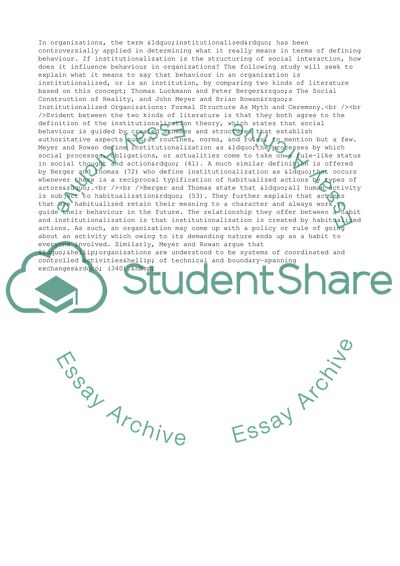Cite this document
(What Does It Mean to Say That Behavior in Organizations Is an Institut Essay, n.d.)
What Does It Mean to Say That Behavior in Organizations Is an Institut Essay. https://studentshare.org/management/1852329-what-does-it-mean-to-say-that-behavior-in-organizations-is-an-institution-or-is-institutionalized-compare-and-contrast-the-answers-to-this-question-that-appear-in-the-work-of-two-or-more-of-the-following-berger-and-luckmann-meyer-and-rowan
What Does It Mean to Say That Behavior in Organizations Is an Institut Essay. https://studentshare.org/management/1852329-what-does-it-mean-to-say-that-behavior-in-organizations-is-an-institution-or-is-institutionalized-compare-and-contrast-the-answers-to-this-question-that-appear-in-the-work-of-two-or-more-of-the-following-berger-and-luckmann-meyer-and-rowan
(What Does It Mean to Say That Behavior in Organizations Is an Institut Essay)
What Does It Mean to Say That Behavior in Organizations Is an Institut Essay. https://studentshare.org/management/1852329-what-does-it-mean-to-say-that-behavior-in-organizations-is-an-institution-or-is-institutionalized-compare-and-contrast-the-answers-to-this-question-that-appear-in-the-work-of-two-or-more-of-the-following-berger-and-luckmann-meyer-and-rowan.
What Does It Mean to Say That Behavior in Organizations Is an Institut Essay. https://studentshare.org/management/1852329-what-does-it-mean-to-say-that-behavior-in-organizations-is-an-institution-or-is-institutionalized-compare-and-contrast-the-answers-to-this-question-that-appear-in-the-work-of-two-or-more-of-the-following-berger-and-luckmann-meyer-and-rowan.
“What Does It Mean to Say That Behavior in Organizations Is an Institut Essay”. https://studentshare.org/management/1852329-what-does-it-mean-to-say-that-behavior-in-organizations-is-an-institution-or-is-institutionalized-compare-and-contrast-the-answers-to-this-question-that-appear-in-the-work-of-two-or-more-of-the-following-berger-and-luckmann-meyer-and-rowan.


